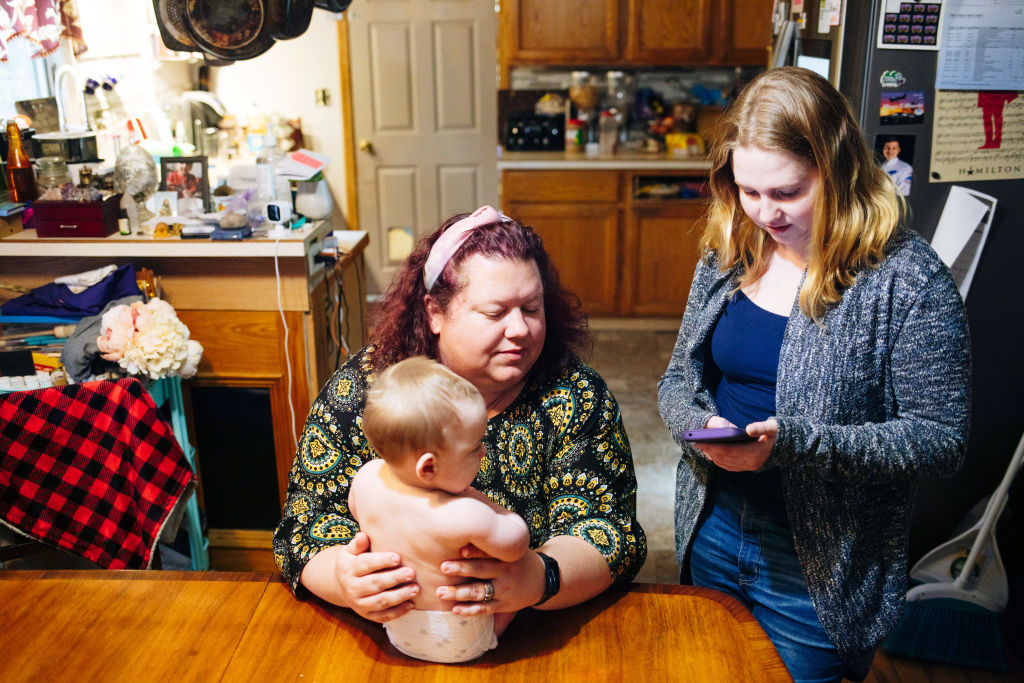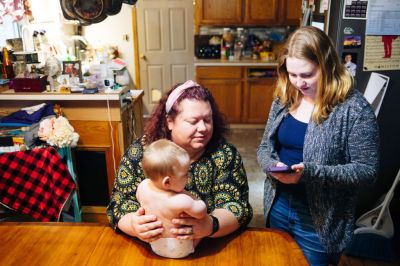In 2021, Democrats succeeded in temporarily expanding the child tax credit (CTC) as part of President Biden’s American Rescue Plan. Previously, the maximum CTC of $2,000 per child was available only to workers with income tax liability and who exceeded an earnings threshold. The expansion gave every family $3,000 per child—$3,600 for younger children—regardless of whether it had any earnings.
Debate over this expansion, which lasted only a year because Democrats failed to make it permanent, has centered on the short-term benefits and the potential long-term costs. Because of those costs—in particular the threat to child upward mobility—I opposed the expansion. But I have agreed with supporters that it caused a large reduction in child poverty in 2021 and that the policy’s expiration contributed to an increase in child poverty in 2022.
But long-term costs aside, new evidence complicates the leading narrative around short-term benefits. Rather than child poverty falling and then rising as the CTC became more and then less generous, child poverty was lower than ever before in 2022.
For some background, the Census Bureau reports two measures of poverty each year: the “official poverty measure” (OPM) and the “supplemental poverty measure” (SPM). Both the OPM and SPM are flawed, but the SPM does a better job of capturing all the income families receive. For example, in 2020 and 2021, aid to families spiked in response to the COVID-19 pandemic. But much of this aid—including the three rounds of economic impact payments (“stimulus checks”), expanded food assistance, and expanded CTC benefits—was ignored by the OPM because it does not count tax refunds or noncash benefits as income. In contrast, the SPM counted this aid.
The OPM showed an increase in child poverty in 2020, and then little change in 2021 and 2022 (declining somewhat, if anything). But most analysts dismissed that result and focused instead on the SPM.
The SPM showed child poverty falling in 2020 to 9.7 percent from 12.6 percent in 2019. Child poverty then fell again in 2021, to 5.2 percent, an all-time low. But in 2022, it rose to 12.4 percent—essentially back to its 2019 rate. (As a side note, that 2019 rate was an all-time low at the time, so the 2022 SPM shows child poverty was lower in any year except 2020 and 2021.)
The SPM child poverty trend has been Exhibit A for advocates of the CTC expansion who argue that its expiration has increased hardship sharply, requiring that it be reenacted—this time permanently. However, a new report from Jeehoon Han, Bruce Meyer, and Jim Sullivan indicates that poverty fell in 2020 and 2021 but also fell in 2022. How can that be?
Rather than looking at income, Han, Meyer, and Sullivan examine consumption—what families spend rather than what they receive. There are a couple of reasons that consumption and income poverty measures lead to different conclusions about recent trends.
The less important one has to do with the way that the Census Bureau estimates CTC benefits. It counts CTC benefits (net of income tax paid) as income, but it allocates that income to the tax year to which the benefits apply rather than in the calendar year in which they are actually received. Normally that's not a big deal, as the CTC doesn't change much year to year. When people got a check comprising their refundable CTC after filing their taxes in early 2019, the Census Bureau counted that as income in 2018 but it counted the check they got in early 2020 toward 2019. So it's usually a wash.
But when the CTC was expanded in 2021, the Census Bureau counted the entire amount as income received in 2021, even though half the expanded amount was received only in 2022 after people filed their taxes. Then in 2022, it included only the (smaller) CTC amount people received in 2023 when they filed their 2022 taxes.
The expanded CTC didn't just let people spend more in 2021 (or let them save more or pay down more debt), it let them do so in 2022 as well. It doesn't make sense to allocate the full benefit of the expansion to 2021.
That said, Han, Meyer, and Sullivan show that even ignoring the CTC, child poverty based on income rose in 2022. (That’s mostly because the “stimulus” checks of 2021 were absent in 2022.)
But the more important reason that consumption poverty fell in 2022 while income poverty rose is that families can smooth their consumption across years if they receive more income in the first year than in the second. They can save some of the income from the first year and spend it in the second year. The unprecedented expansion of the safety net did not just let people spend more in 2020 and 2021 (or let them save more or pay down more debt), it let them do so in 2022 as well. It doesn't make sense to allocate the full benefit of the expansion to 2020 and 2021.
Savings spiked in 2020 and 2021. By the federal definition, “personal savings” is just discretionary income less spending on things consumed. Among middle-class and richer folks, the savings spike meant actual saving and investing. Among poorer folks, it more often meant paying down debt.
Some families used part of their stimulus checks (or their monthly CTC checks) to pay off credit card debt in 2021 but still had enough money left over to afford more than they could in 2020. These families experienced less hardship than in the previous year. Income poverty and consumption poverty both would show a decline.
In 2022, many of these same families could afford more than they could in 2021, because rather than having to pay down credit card debt, they now could spend the money for other things. In other words, many families continued to benefit in 2022 from the expanded safety net of 2020 and 2021. They experienced less hardship than in the previous year. But while a consumption poverty measure would correctly register this improvement, an income poverty measure might incorrectly indicate rising hardship.
The instinct of many left-leaning analysts will be to say that consumption poverty is not as well-measured as income poverty, so we should trust the SPM figures that show child poverty rising in 2022. But they have not really grappled with the evidence on which is better measured, something I have pointed out in the past and that Han, Meyer, and Sullivan discuss. Consumption poverty is at least as well-measured as income poverty.
So it now looks to me like I may have been wrong. Not about the long-term risk of a permanently expanded CTC: making the 2021 expansion permanent would have been a mistake, because its omission of an earnings requirement would have incentivized single parenthood and, as Meyer and my colleague Kevin Corinth have demonstrated, joblessness, both of which would hurt the most disadvantaged children. Nor was I wrong about the short-term poverty-reducing effect of a temporary CTC expansion. Rather, it appears that because of consumption smoothing, child poverty was at an all-time low last year despite the expiration of the temporary CTC expansion; it did not revert to its higher pre-pandemic level.
To be sure, the expansion had costs—budgetary and inflationary—and a permanent expansion would have entailed more costs in the form of unintended consequences. But along with other temporary expansions of the safety net, it did reduce child poverty in the short run, an effect that persisted into 2022. It’s just that advocates of a permanently expanded CTC can’t point to higher income poverty in 2022 to justify their preferred policy.
Advocates might instead point to the 2022 decline in consumption poverty to justify a permanent CTC expansion, but one suspects that few will take up this line of argument. It implies the safety net expansion of 2021 was larger than necessary to keep poverty rates at record lows. And it’s not necessarily the case that consumption poverty would have been higher in 2022 if not for the unprecedented expansion of the safety net. The aid provided by the American Rescue Plan Act, coming on the heels of an enormous relief effort in 2020, allowed for saving and debt reduction, but it also worsened inflation, which ate into living standards. No ARP, no expanded CTC, but also less inflation.
The bottom line is that economic hardship among children was never before as low as it was in 2022. With the economic growth and moderating inflation that has occurred since, we may find it is even lower in 2023. Ultimately, short-term income and consumption poverty trends cannot tell us how we should design safety nets, absent consideration of short- and long-term costs and the values that are reinforced or weakened by different ways of providing assistance. Safety nets should provide temporary relief, but they should otherwise promote self-sufficiency and upward mobility. There are better ways to do that than a permanently expanded CTC that gives the same amount to non-workers as to workers.





Please note that we at The Dispatch hold ourselves, our work, and our commenters to a higher standard than other places on the internet. We welcome comments that foster genuine debate or discussion—including comments critical of us or our work—but responses that include ad hominem attacks on fellow Dispatch members or are intended to stoke fear and anger may be moderated.
With your membership, you only have the ability to comment on The Morning Dispatch articles. Consider upgrading to join the conversation everywhere.